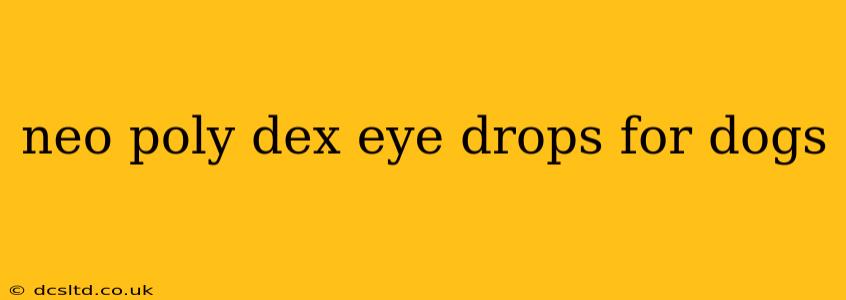Neo Poly Dex is a common ophthalmic solution used to treat various eye conditions in dogs. This comprehensive guide will explore its uses, potential side effects, and crucial information for pet owners. Understanding this medication can empower you to provide the best possible care for your canine companion.
What is Neo Poly Dex?
Neo Poly Dex is a triple antibiotic ophthalmic solution containing neomycin, polymyxin B, and dexamethasone. Each component plays a vital role in treating canine eye infections:
- Neomycin: A broad-spectrum antibiotic effective against a wide range of bacteria.
- Polymyxin B: Another antibiotic, particularly effective against gram-negative bacteria.
- Dexamethasone: A corticosteroid that reduces inflammation and swelling.
This combination makes Neo Poly Dex effective against bacterial infections while simultaneously managing the inflammation often associated with such conditions.
What Conditions Does Neo Poly Dex Treat in Dogs?
Neo Poly Dex is frequently prescribed to treat bacterial conjunctivitis (pink eye) and other bacterial infections of the eye in dogs. The medication's ability to target bacteria and reduce inflammation makes it a valuable tool in managing these conditions. However, it's crucial to remember that this medication should only be used under the direction of a veterinarian. Improper use can lead to complications.
What are the potential side effects of Neo Poly Dex?
While generally safe when used as directed, Neo Poly Dex can have side effects. These are relatively uncommon but should be monitored:
- Eye irritation: Some dogs may experience temporary stinging or burning upon application.
- Allergic reactions: Although rare, allergic reactions are possible. Signs might include increased swelling, redness, or discharge.
- Increased intraocular pressure (IOP): Prolonged use can potentially increase IOP, especially in dogs with pre-existing glaucoma. This is why regular veterinary check-ups are essential.
How is Neo Poly Dex applied to a dog's eye?
The application process is relatively straightforward, but following your veterinarian's instructions precisely is crucial. Generally, a small amount of the solution is instilled into the affected eye(s) several times a day. Always clean the area around the eye before application to prevent contamination.
How long does it take for Neo Poly Dex to work?
The time it takes for Neo Poly Dex to show improvement varies depending on the severity of the infection. You should see noticeable improvements within a few days, but complete healing may take longer. Do not discontinue use prematurely, even if improvement is apparent. Continue the treatment as prescribed by your vet.
Can I use human eye drops on my dog?
No. Human eye drops are not formulated for use in dogs and may contain ingredients harmful to them. Always use medication specifically prescribed by a veterinarian for your pet.
What should I do if my dog shows signs of an allergic reaction?
If you notice any signs of an allergic reaction (increased swelling, redness, discharge), discontinue use immediately and contact your veterinarian.
When should I contact my veterinarian?
Contact your veterinarian if:
- Your dog's condition worsens or doesn't improve after a few days of treatment.
- You observe any unusual side effects.
- You have any questions or concerns about using Neo Poly Dex.
Are there alternatives to Neo Poly Dex?
Yes, there are other ophthalmic solutions available to treat canine eye infections. Your veterinarian will determine the best course of action based on your dog's specific needs and the nature of the infection. They may choose a different antibiotic or a different combination of medications.
Disclaimer: This information is for educational purposes only and should not be considered veterinary advice. Always consult with a veterinarian before administering any medication to your pet. They can diagnose the underlying condition and recommend the appropriate treatment plan. Only a veterinarian can accurately assess your dog's needs and determine the most suitable course of action.
